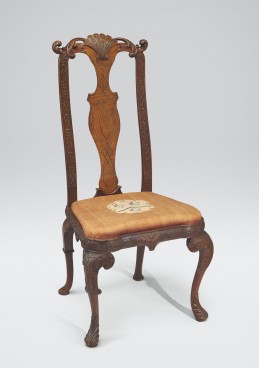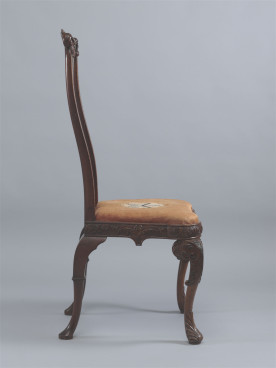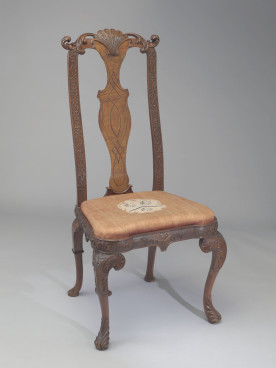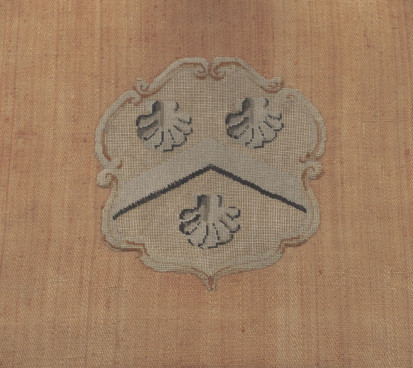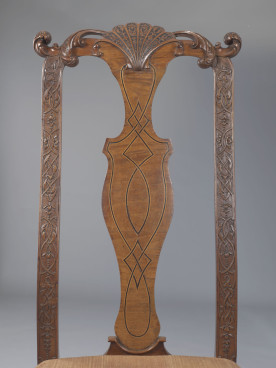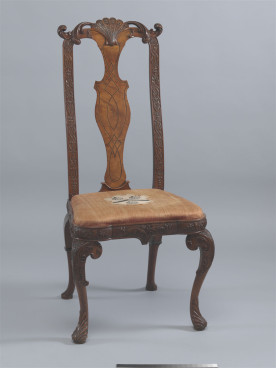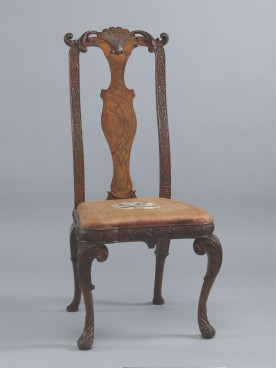Chair, c.1720–30
Walnut, now with 18th-century fabric and needlework
This chair is one of a pair from a set of at least twelve chairs from Arley Castle, Kidderminster, Worcestershire. The needlework depicts the crest of the Lyttleton family, which lived at Arley Castle.
Adam Bowett Catalogue (19/08/2012)
Description
A pair of walnut chairs, c.1720-30. The tall, narrow back is surmounted by a decorated scallop shell with pierced scrolls issuing to either side, over a baluster inlaid with black and white interlaced stringing, between back posts carved with shallow relief Berainesque strapwork. The slip seat is applied with the needlework crest of the Lyttleton family. The compass rails have a convex section, carved in shallow relief with palm branches to the front, and recessed in the centre. The carved, scrolling cabriole forelegs descend to fluted leaf or shell-carved feet, the back legs being plainer with gaiters half-way down, ending in pad feet.
Dimensions
H: 45 ½“ (116cm) Seat height: 17 ½” (45cm) W: 21 ¾” (55cm) D: 21“ (54cm)
Materials
Walnut, oak
Dating criteria
The narrow, un-waisted backs suggest an early date, close to 1720, but the design is so unusual that it is difficult to cite comparable dated examples.
Construction
The back legs and posts are in one piece of solid walnut, tenoned into the crest rail. Both back legs are thicknessed on the outside faces of the knee and the foot. The splat is solid walnut, veneered on the front face and tenoned into the crest rail and into the shoe. The shoe and the back seat rail are in two parts, both solid walnut. The back rail is presumably tenoned into the rear posts. The side and front seat rails are oak, with a thick facing of walnut and deeply rebated to receive the seat. The front and side rails are tenoned into the tops of the solid walnut forelegs and the joint is supported by curved oak glue blocks with similar blocks fitted in the back corners. Further support is provided by carved walnut brackets which also have oak glue blocks to support them.
Marks or stamps
26.1 – The top edge of the front seat rail is marked II.
26.2 – The top edge of the front seat rail is marked IIII.
Condition
26.1 – Condition is generally good, there are no significant breaks. All surfaces have been extensively cleaned with little patination remaining. The entire back of the splat has been veneered, which appears intended to give support to several badly wormed areas. There is also a patched in repair to the lower right side of the splat. Rails and glue blocks appear to be original. Both side rails have patched repairs extending to the joints with the front legs and presumably including a new tenon. There is serious historic worm infestation to the left side of the back rail and support blocks added to the left rear leg. There is a shallow rectangular slot cut into the inside face of the back rail immediately below the shoe in line with the splat, whose purpose is unclear.
The drop in seat frame is mortised-and-tenoned in the usual manner. It appears to be original and retains eighteenth century webbing and bottom cloth, now distressed.
26.2 – Condition is very good. There is a repaired break to the joint between the crest rail and the left back post. All rails and blocks appear to be original. Considerable worm infestation to the rear seat rail. There is the same unexplained slot cut in the seat rail as for 26.1. At some time in the past the joint between the left seat rail and the left front leg was strengthened with two screws, now removed.
Additional remarks
These enigmatic chairs are part of a set of at least twelve. Six were recorded at Arley Hall (later Arley Castle), Worcestershire, in a sale catalogue of 1852. Arley Hall was one of the homes of the Lyttleton family, whose crest is on the seats of the two chairs. The house and contents were sold in 1852, and the new owners were the Woodward family. They presumably wanted to retain some of its historic furnishings and so bought the six chairs. Descendants of the family subsequently offered two pairs for sale at Sotheby’s in London on 16 November 1990 and 5 July 1991 respectively. The 1990 pair were first acquired by Neil Sellin, then sold to Ronald A. Lee, from whom John Bryan bought them in 2001. These chairs are numbered II and IIII. The 1991 pair was almost certainly resold at Sotheby’s London on 30 June 2004. They are numbered I and VI.
Another group of seven chairs was in the United States at the beginning of the 20th century. They were sold by Arthur Vernay to Mrs Morton Plant, wife of a New York banker, about 1905-12. After her death in 1956 the chairs were bought back by Vernay at a Park Bernet auction, 15 January 1957. One of the chairs was acquired by the Gersh family of New York at an unknown date, the remaining six being bought by a collector at Christie’s, New York, in 1994. These six are numbered V, VII, VIII, X, XI, XII.
Thus far the chairs numbered I-XII (1-12) are accounted for except for III (3) and VIIII (9).
In June 1936 Mallet’s Exhibition of Old English Furniture included two of these chairs, perhaps the missing pair from Arley Castle (nos. III & VIIII?). It is possible that these chairs were the ones subsequently seen by Michael Hill in San Francisco, belonging to the Cooley family. A pair now owned by an American collector are perhaps the same pair.
If this hypothesis is correct, there remain two anomalous chairs. The Gersh family chair, one of the seven originally sold to Mrs Morton c.1905 and bought back by Vernay in 1957, was sold at Sotheby’s New York, 18 October 2006. According to Peter Holmes it is unnumbered (the present location of this chair is known to Peter Holmes). Finally, there is the chair sold from Ronald Lee’s estate by Sotheby’s, London, on 28 November 2001. This chair had a (replaced?) splat with carved rather than inlaid decoration. The chair is marked, but the number is odd, resembling two conjoined V’s, one upside down.
References
Edwards (ed.), The Dictionary of English Furniture, 3 Vols. London (1954), I, p. 255, fig. 8.
Exhibition of Art Treasures, 30th April – 26th May 1928 no. 43.
Grindley, The Bended Back Chair, London (1990), No. 16.
Exhibited Grosvenor House Antiques fair 12-22 June 1991.
Provenance
Arley Castle, Worcestershire, sold by Ferebrother Clark and Lye 6-18th December 1852, lot 1644-1646 (sold in three pairs), purchased by R. Woodward.
Sotheby’s London, 5th July 1991, Lot 59.
Purchased from Ronald A. Lee, London, September 1991.

